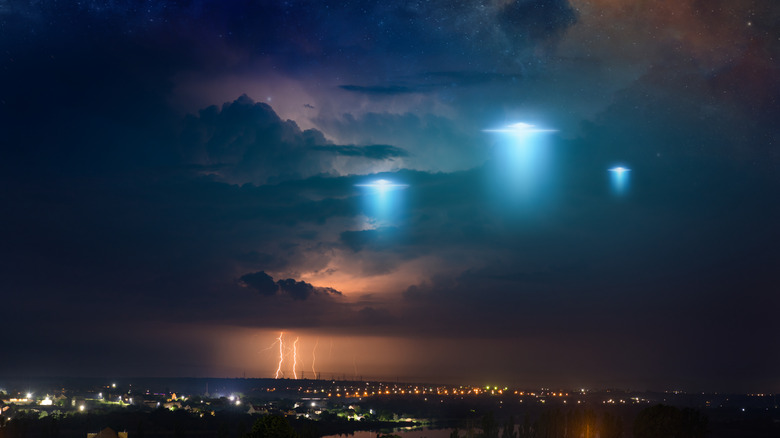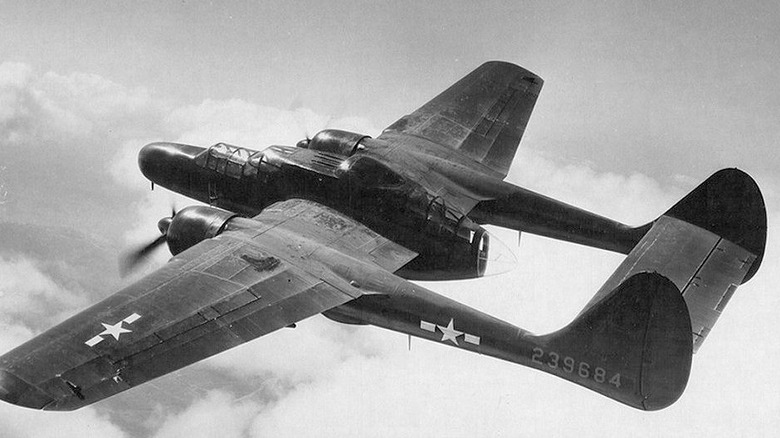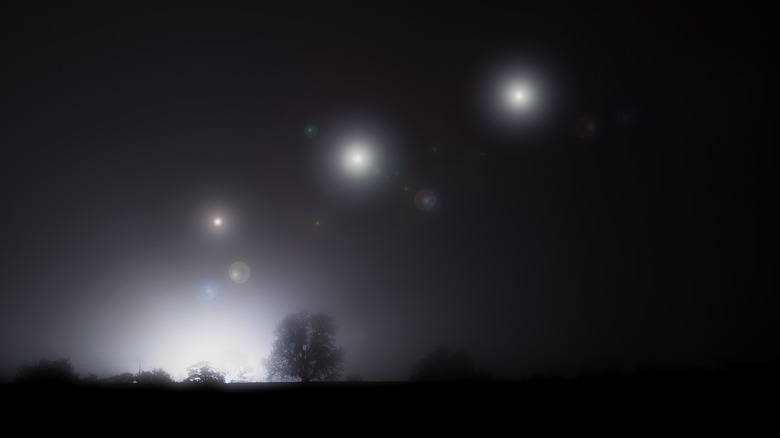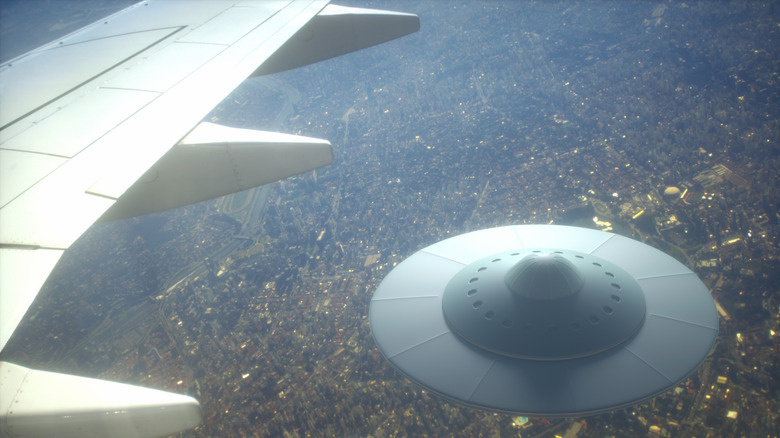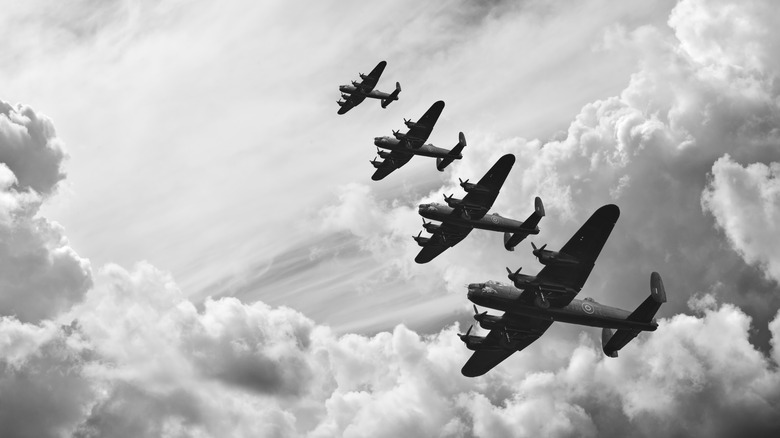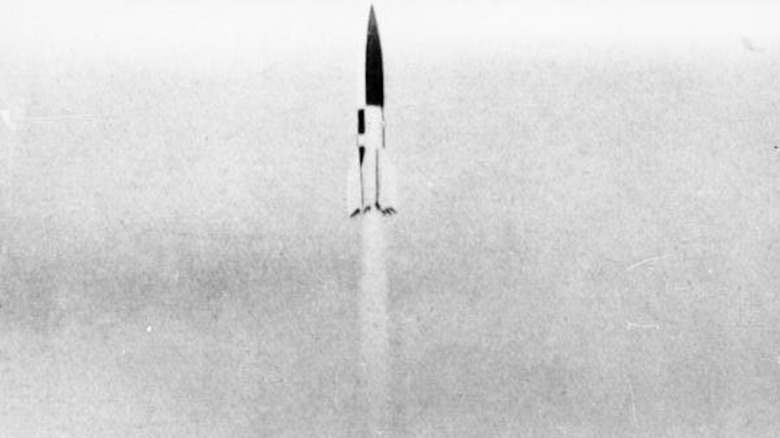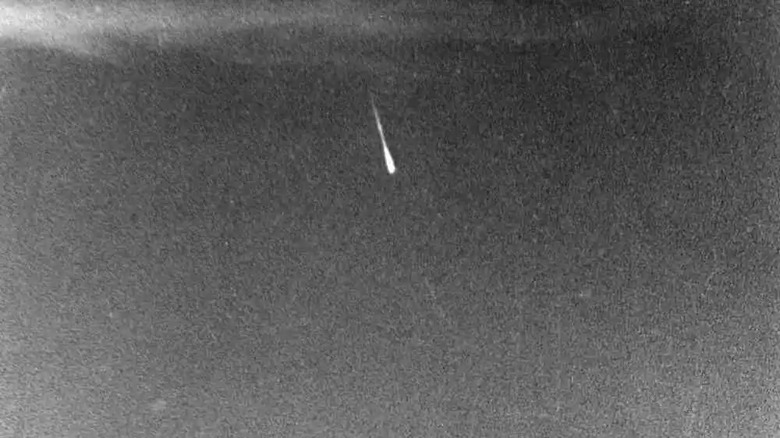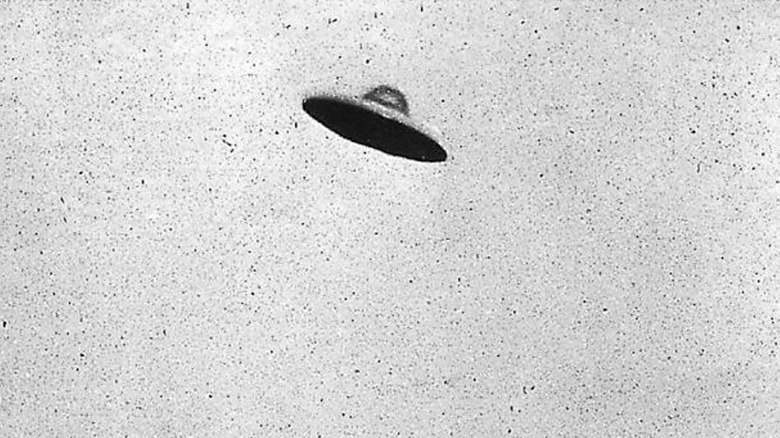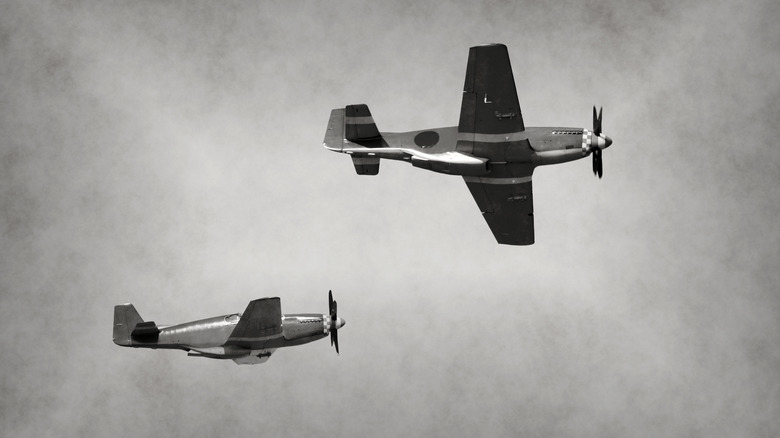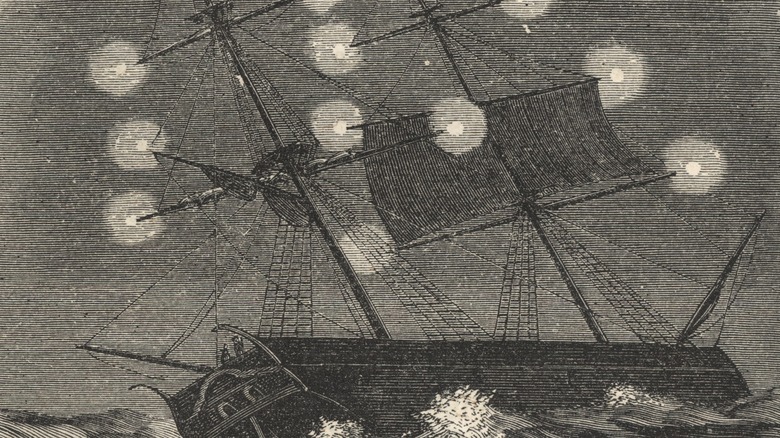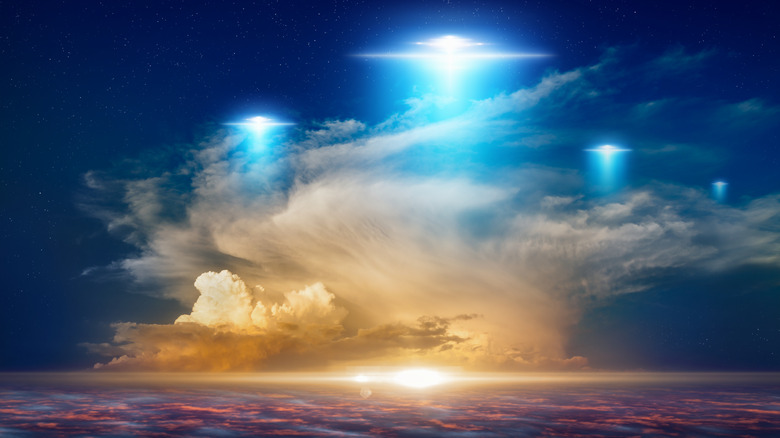The Mysterious Foo Fighters Of World War II
When most people hear "foo fighters," they'll immediately think of the band led by rock legend Dave Grohl. The phrase, however, is a lot older than the band. It's actually an old word for UFOs, dating back to World War II. By the 1990s, UFOs were firmly a part of popular culture, spurred by TV shows like "The X-Files" (which Grohl would later make a cameo appearance on). Being a UFO enthusiast himself was what led him to pick the name, but the old sightings of the actual foo fighters date back to before terms like UFO and flying saucer were part of our everyday lexicon; these words were first used in the mid-to-late 1940s but didn't become widely recognized in until the 1950s.
One of the most prominent early UFO sightings happened during the latter years of World War II. According to The History Channel, it was in November 1944 that three U.S. Air Force personnel saw unexplained lights up in the sky during a night flight. Fred Ringwald, Ed Schlueter, and Donald J. Meiers, all Air Force lieutenants, were on a night flight over the Rhine Valley when a series of 8-10 bright orange lights appeared over the hills. They mistook them for enemy fighters at first, but by the time they'd turned their plane to intercept them, the lights had vanished. Reportedly, the three were hesitant to mention what they'd seen at first, but other pilots in their squadron soon also reported that they'd seen similar things.
The first of the foo fighters
While many later UFO sightings come from eyewitnesses disputed as unreliable, the foo fighters were seen by reliable members of the military, lending credibility to the reports. The three airmen, Ringwald, Schlueter, and Meiers, were part of the U.S. Air Force 415th Night Fighter Squadron, based in South France at the time, and in late 1944 saw reports of unidentified lights in the sky start to come in thick and fast from their fellow aircrews. Pilots began to refer to any and all sightings as "those f*cking foo fighters," describing them as strange glowing lights, white, orange, red, or "fiery." They could make seemingly impossible maneuvers in the sky before vanishing without a trace. According to a 1945 report by Time, pilots described them as like flares, following their aircraft uncomfortably closely for miles, even at high speeds. One in particular mentioned red fireballs off his wing tips, which didn't leave until he dropped into a dive at 360 miles per hour.
Seemingly, there were a variety of objects reported as foo fighters; sightings included things like lights flying in formation and wingless cigar-shaped objects. Rather than moving at random, the lights seen by pilots appeared to be "under perfect control at all times." With such a plethora of reports, it was only a matter of time before the term "foo fighter" made it into popular culture. It was first popularised by an article in The New York Times on January 2, 1945.
Naming the lights in the sky
The name "foo fighter" is purposefully silly sounding, giving an appropriately absurd name to seemingly absurd circumstances. Trapped in such a deeply stressful situation, keeping a sense of humor was a coping mechanism for American military personnel during World War II. The choice of a comical name worked to take the edge off what were no doubt deeply unsettling experiences for aircrews in the sky. After all, at the time, radar was still a new technology and U.S. pilots had only been involved in nighttime operations for a few years. The night skies were still very much unfamiliar territory for American pilots, and the constant chance of seeing unexplained things while flying would be enough to unnerve even the most steadfast of pilots.
The name itself most likely came from an American comic strip by the name of Smokey Stover. Popular at the time, Stover himself was a firefighter, with the comic detailing his wacky adventures. The nonsense word "foo" was used frequently in the comic, thrown in at random for the sake of absurdist comedy. The name could possibly have come from the phrase "where there's foo, there's fire," or possibly from a 1938 book entitled, simply, "The Foo Fighter." It was reportedly Donald J. Meiers who coined the term, according to Smithsonian Magazine. As one of the first of the 415th Night Fighter Squadron to see the lights for himself, it feels appropriate that he'd be the one to name them.
Foo fighters around the world
There were plentiful foo fighter sightings in Europe, but they were also seen in other parts of the world during the Second World War, often reported by members of the military. One account is given in the book, "Bringing the Thunder: The Missions of a World War II B-29 Pilot in the Pacific." In it, a bomber pilot talks about a mission over Tokyo, where several people witnessed an unidentified object. They described it as "a large burning sphere hanging out there in the sky." The sphere appeared aerodynamically incapable of flight and didn't seem to have any means of propulsion, but it reportedly followed their planes before it was shot down. Minutes later, a second was seen, also pursuing them and prompting the pilots to flee. Similar fireballs were reported by crews on other missions too, but when military intelligence heard about the mysterious fireballs they had no explanation for what they could have been.
Elsewhere in the world, possibly the earliest wartime UFO sighting was over the Indian Ocean. The book "UFOs and the National Security State" mentions this event happening in September of 1941. The SS Pulaski, a Polish ship converted for use by the British military, was out at sea when soldiers saw the object in the sky. Appearing about half the size of the full moon, they described it as a globe of greenish light. Alerted to the object, a gunner watched it follow their ship for about an hour.
Wartime UFO sightings
While it was the U.S. Air Force who gave the UFOs the name of foo fighters, reports of strange phenomena in the skies had begun much earlier. After all, with World War II having begun in 1939, there had been plenty of airplanes in the skies over Europe for years. The U.K.'s Royal Air Force had been sending out bomber crews regularly, and several of them had reported lights in the sky, glowing objects, and things that had been officially dubbed "aeroforms." The reports from British pilots date back to March 1942, and there were numerous other reports worldwide in the early 1940s. Another incident was in the U.S. in 1942, when unidentified craft flew over Los Angeles seemingly causing a blackout. Originally assumed to be Japanese aircraft, there was never any explanation for what the mysterious objects were.
Seemingly though, the majority of sightings were reported in 1944 over Europe. According to the book "Smokin' Rockets," the sightings were so numerous that many allied soldiers started assuming them to be German aircraft, leading them to be sometimes nicknamed "kraut fireballs." Despite the concerns that these were enemy vehicles though, the foo fighters were never reported to cause any damage to aircraft. Aircrews began to consider them more of a nuisance than any actual threat, as they tended to simply follow airplanes. All the same, pilots remained wary because the unknown objects were impossibly maneuverable, easily managing to evade entire squadrons of fighters.
Rumours of secret weapons
In the nerve-wracking grip of the ongoing war, there was no shortage of speculation that the German Luftwaffe may have been responsible for the foo fighters. Rumors began to simmer, and people seemingly had good reason for their suspicions. By this point, German engineers had invented the V-2 rocket, the world's first long-range guided ballistic missile. Germany had already been firing rockets at Britain for years, and the first V-2 Rocket had struck London in September 1944. But the V-2 wasn't maneuverable enough to match what pilots had reported seeing in the skies over the Rhine valley. It also seemed like quite a coincidence that, as The Sarasota Herald-Tribune mentions, when allied forces captured the East Rhine, sightings of foo fighters in the area stopped.
With all of this on their minds, people began to worry about some kind of German superweapon. The rumors began to spread so persistently that it was even reported by newspapers. One published news article referred to a "floating mystery ball" as a new airborne weapon, giving a description that clearly refers to the foo fighters. However, as history can attest, this would later turn out not to be the case. In fact, the book "Smokin' Rockets" notes that unidentified objects had also been reported by both German and Japanese aircrews. Whatever the strange objects were, seemingly they were a puzzle to pilots on both sides of the conflict.
Scandinavian Ghost Rockets
In September 1945, World War II came to an end, but the sightings of mysterious objects in the skies continued. It's uncertain whether they were related to the foo fighters seen by wartime pilots but 1946 saw Scandinavia inundated with sightings of strange objects dubbed "ghost rockets." At least one incident, per The New York Times, almost caused casualties as a ghost rocket crashed into a lake. They were believed to originate from somewhere near Germany and fragments were reportedly recovered, but specific details remained elusive. The Swedish military investigated, finding that the rockets could fly as far as 800 miles — an unprecedented distance for a ballistic missile at the time, with German V-2 rockets having a maximum range of just 220 miles. They wouldn't release their files on the sightings until 40 years later when it was revealed that Sweden had classified over 1,500 ghost rocket reports.
Over the following months, there was a spate of sightings of these ghost rockets. As The Deccan Chronicle mentions, they were even seen over the Finnish capital of Helsinki. One passed over the city, making a thunderous noise and leaving a trail of luminous smoke that hung in the air for around 10 minutes. Another, also over Helsinki, was seen to turn in the air and reverse direction. As the ghost rockets over Scandinavia started to taper off around the end of 1946, sightings of similar objects were reported further south, in Hungary, Greece, Portugal, and Morocco.
The birth of the UFO craze
The foo fighters were well documented during wartime, but it wasn't until later that the term UFO would enter popular consciousness. The sighting which would kick off the cultural phenomenon of UFOs, per The History Channel, happened in 1947 — but the event itself seems eerily similar to the reports of foo fighters. A businessman by the name of Kenneth Arnold was flying a private light aircraft near Mount Rainer in Washington when he reported seeing nine glowing objects in the sky. He described them as crescent-shaped and traveling at what he estimated to be several thousand miles per hour. A newspaper report would later mistakenly report these objects as being "saucer-shaped," leading the flying saucer to become part of our vocabulary. The same year, the Roswell Incident would capture the imagination of the world, with the U.S. Military initially reporting that they'd recovered the wreckage of a "flying disc."
The objects seen by Arnold were reportedly flying in an echelon formation, much like the foo fighters reported by World War II pilots. The idea of flying saucers would become a firm part of pop culture, starting in mid-20th century sci-fi movies like "Earth vs. the Flying Saucers" and "Plan 9 From Outer Space," persisting until more recent fiction like "The X-Files." A declassified CIA report from 1953 discusses the foo fighters, making a point to note that, "if the term 'flying saucers' had been popular in 1943-1945, these objects would have been so labeled."
Optical illusions among aircraft pilots
With so many UFOs being reported by aircrews, the U.S. Military began a serious investigation into possible causes. They had to consider the possibility that something might be affecting the perceptions of the people involved. Wartime had forced militaries to move quickly, meaning there were plenty of potential gaps in knowledge about the physical rigors to which air force members were being subjected. One thing military scientists investigated was aviator's vertigo. According to an article in Skeptic Magazine, this is a feeling of disorientation caused by the motion of an aircraft, which can have a number of effects on a flight crew. Essentially, it covers any sensation or perception which doesn't match the objective reality of the environment. One effect of aviator's vertigo is a sensation known as autokinesis, an optical illusion that gives the impression that stationary objects are actually moving. The result is that points of light can appear to move.
This study followed up an earlier idea that the foo fighters were hallucinations seen by aircrews suffering from "battle fatigue." Also known as combat fatigue or shell shock, this is a condition brought on by the stress of spending time in active warzones. Soldiers from battle fatigue can experience hypersensitivity to light and movement, suggesting that it could combine with aviator's vertigo to give the illusion of moving lights in the sky. However, as Smithsonian Magazine notes, the crews themselves disagreed with this assessment. Simply, it didn't match what they'd experienced.
What were the foo fighters?
There was a lot of speculation among scientists about what the foo fighters might actually have been, and one likely culprit was some kind of atmospheric phenomenon. Earth's atmosphere is home to a wide variety of optical effects, like reflections off high-altitude ice crystals which can cause the light to play tricks on observers. Additionally, there are a few electrical phenomena in the atmosphere which could potentially explain what pilots had seen. In 1945, Time reported that scientists considered the foo fighters might have been St Elmo's fire, an optical where an electrical discharge can emit light. St Elmo's fire has been well-known for a long time, often seen on the masts of ships out at sea. With the right weather conditions, it can also be seen on church steeples and aircraft. But as seasoned military pilots, many of those who reported seeing foo fighters were familiar with St Elmo's fire.
Another possibility, which seems like a better match, is ball lightning. This is a mysterious and poorly understood electrical phenomenon, usually seen during thunderstorms, where a sphere of glowing light can appear in the air. Ball lightning can have varying colors, from blue to yellow to orange, and even now in the 21st century, little is known about it. However, this doesn't seem to fully explain the foo fighters reported by pilots either. Whatever they really were, the foo fighters were seemingly unlike anything else seen before.
An unsolved mystery
During the 1940s, numerous pilots gave reports about seeing the mysterious foo fighters while flying at night. Many of them had found the experience deeply unsettling, and with good reason too. It's hard for anyone to rationalize seeing things that they can't explain. The pilots involved, however, all maintained a professional attitude when speaking on the record. Per Smithsonian Magazine, none of them ever formally speculated on what exactly they might have seen in the air. There have been many attempts to try and explain the sightings, from St Elmo's fire to hallucinations, but none seem to accurately match what the aircrews described they'd seen.
Unfortunately, though, eyewitness accounts were essentially all investigators had to go on. With none ever causing damage to aircraft, the foo fighters had vanished without ever leaving any physical trace. None were ever confirmed by radar either — but radar was still a new technology at the time, being first used to detect aircraft in 1938. All kinds of explanations have been explored, from tracer fire to light reflected by atmospheric ice crystals, to mysterious secret wartime weapons. Still, nothing has ever been able to adequately explain what the foo fighters were. It remains a mystery to this day, and perhaps it always will be.
